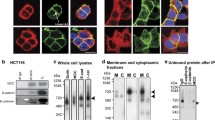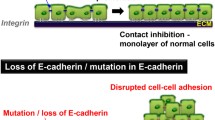Abstract
Background: The clinical behavior of colorectal cancer depends on its ability to invade and metastasize. Metastatic cells must dissociate from other cells and invade through basement membrane and stroma. Cell-cell adhesion in epithelial cells is mediated by the cell surface protein E-cadherin in association with α- and β-catenin, which link E-cadherin to the cytoskeleton. Decreased cell-cell adhesion and increased motility on laminin have been correlated with more poorly differentiated and aggressive carcinomas.
Methods: In this study, the RKO cell line, previously shown by us to lack E-cadherin expression, was transfected with the complementary DNA for E-cadherin. The transfectants were selected for high levels of surface expression by sequential FACS and examined in functional assays.
Results: In comparison to control transfectants, the E-cadherin transfectants exhibited a more epithelial-like morphology, a 30% increase in Ca2+-dependent cell-cell aggregation, and a markedly reduced motility on the matrix proteins, collagen I and laminin.
Conclusions: These data demonstrate that correction of a defect in the cadherin/catenin cell-cell adhesion complex, often found in poorly differentiated and highly invasive tumors, facilitates increased cell-cell adhesion and retards tumor cell migration on basement membrane and stromal proteins.
Similar content being viewed by others
References
Steinberg SM, Barwich KW, Stablein DM. Importance of tumor pathology and morphology in patients with surgically resected colon cancer. Findings from the Gastrointestional Tumor Study Group.Cancer 1986;58:1340–5.
Mentges B. Colon carcinoma: preoperative CEA, tumor differentiation, and prognosis.Dtsch Med Wochenschr 1987;112:1245–9
Ming SI, Goldman H.Gastrointestional pathology. Philadelphia: Saunders, 1992.
Terranova VP, Hujanen ES, Martin GR. Basement membrane and the invasive activity of metastatic tumor cells.J Natl Cancer Inst 1986;77:311–16.
Frixen UH, Behrens J, Sachs M, Eberle G, Vous B, Warda A, Lochner D, et al. E-cadherin-mediated cell-cell adhesion prevents invasiveness of human carcinoma cells.J Cell Biol 1991;113:173–85.
Takeichi M. Functional correlation between cell adhesive properties and some cell surface proteins.J Cell Biol 1977;75:464–74.
Tsukita S, Tsukita S, Nagafuchi A, Yonemura S. Molecular linkage between cadherins and actin filaments in cell-cell adherens junctions.Curr Opin Cell Biol 1992;4:834–9.
Nagafuchi A, Takeichi M, Tsukita S. The 102 kd cadherin-associated protein: similarity to vinculin and posttranscriptional regulation of expression.Cell 1991;65:849–57.
Nagafuchi A, Takeichi M. Transmembrane control of cadherin-mediated cell adhesion: a 94 kDa protein functionally associated with a specific region of the cytoplasmic domain of E-cadherin.Cell Regul 1989;1:37–44.
Ozawa M, Ringwald M, Kemler R. Uvomorulin-catenin complex formation is regulated by a specific domain in the cytoplasmic region of the cell adhesion molecule.Proc Natl Acad Sci USA 1990;87:4246–50.
Herrenknecht K, Ozawa M, Eckerskorn C, Lottspesch F, Lenter M, Kemler R. The uvomorulin-anchorage protein α-catenin is a vinculin homologue.Proc Natl Acad Sci USA 1991;88:9156–60.
McCrea P, Turck C, Gumbiner B. A homolog of the armadillo protein inDrosophila (plakoglobin) associated with E-cadherin.Science 1991;254:1359–61.
Knudson K, Wheelock M. Plakoglobin, or an 83 kD homologue distinct from β-catenin, interacts with E-cadherin and N-cadherin.J Cell Biol 1992;118:671–9.
Breen E, Clarke A, Steele G Jr, Mercurio AM. Poorly differentiated colon carcinoma cell lines deficient in α-catenin expression express high levels of surface E-cadherin but lack Ca2+-dependent cell-cell adhesion.Cell Adhesion Commun 1993;1:239–50.
Dorudi S, Sheffield JP, Poulsom R, Northover J, Hart IR. E-cadherin expression in colorectal cancer.Am J Pathol 1993;142:981–6.
Doki Y, Shizaki H, Tahara H, Inoue M, Oka H, Iihara K, Kadowski T, et al. Correlation between E-cadherin expression and invasiveness in vitro in a human esophageal cancer cell line.Cancer Res 1993;53:3421–6.
Bringuier PP, Umbas R, Schaafsma HE, Karthaus HF, Debruyne FM, Schalken JA. Decreased E-cadherin immunoreactivity correlates with poor survival in patients with bladder tumors.Cancer Res 1993;53:3241–5.
Kadowaki T, Shiozaki H, Inoue M, Tamura S, Oka H, Doki Y, Iihara K, et al. E-cadherin and α-catenin expression in human esophageal cancer.Cancer Res 1994;54:291–6.
Shimoyama Y, Hirohashi S, Hirano S, Noguchi M, Shimosato Y, Takeichi M, Abe O. Cadherin cell-adhesion molecules in human epithelial tissues and carcinomas.Cancer Res 1989;49:2128–33.
Schipper J, Frixen U, Behrens J, Unger A, Jahnke K, Birchmeier W. E-cadherin expression in squamous cell carcinomas of head and neck: inverse correlation with tumor dedifferentiation and lymph node metastasis.Cancer Res 1991;51:6328–37.
Shimoyama Y, Hirohashi S. Cadherin intercellular adhesion molecule in hepatocellular carcinomas: loss of E-cadherin expression in an undifferentiated carcinoma.Cancer Lett 1991;57:131–5.
Behrens J, Mareel MM, Van Roy FM, Birchmeier W. Dissecting tumor cell invasion: epithelial cells acquire invasive properties after the loss of uvomorulin-mediated cell-cell adhesion.J Cell Biol 1989;108:2435–47.
Vleminckx K, Vakaet L Jr, Mareel M, Fiers W, Van Roy F. Genetic manipulation of E-cadherin expression by epithelial tumor cells reveals an invasion suppressor role.Cell 1991;66:107–19.
Sommers CL, Thompson EW, Torri JA, Kemler R, Gelmann EP, Byers SW. Cell adhesion molecule uvomorulin expression in human breast cancer cell lines: relationship to morphology and invasive capacities.Cell Growth Differ 1991;2:365–72.
Shimoyama Y, Hirohashi S. Expression of E- and P-cadherin in gastric adenocarcinomas.Cancer Res 1991;51:2185–92.
Daneker GW Jr, Piazza AJ, Steele G Jr, Mercurio AM. Relationship between extracellular matrix interactions and degree of differentiation in human colon carcinoma cell lines.Cancer Res 1989;49:681–6.
Jun SH, Thompson EW, Gottardis M, Torri J, Yamamura K, Kibbey M, Kim WH, et al. Laminin adhesion-selected primary human colon cancer cells are more tumorigenic than the parental and nonadherent cells.Int J Oncol 1994;4:55–60.
Wewer UM, Albrechtsen R. Carcinoma-associated perisinusoidal laminin may signal tumor cell metastasis to the liver.Virchows Arch A Pathol Anat 1992;421:87–93.
Hynes RO. Integrins: versatility, modulation, and signaling in cell adhesion.Cell 1992;69:11–25.
Boyd D, Florent G, Kim P, Brattain M. Determination of the levels of urokinase and its receptor in human colon carcinoma cell lines.Cancer Res 1988;48:3112–16.
Nagufuchi A, Shirayoshi Y, Okazaki K, Yasuda K, Takeichi M. Transformation of cell adhesion properties by exogenously introduced E-cadherin cDNA.Nature 1987;329:341–3.
Daneker GW Jr, Piazza AJ, Steele G Jr, Mercurio AM. Interactions of human colorectal carcinoma cells with basement membranes.Arch Surg 1989;124:183–7.
Kinsella AR, Green B, Lepts GC, Hill CL, Bowie G, Taylor BA. The role of the cell-cell adhesion molecule E-cadherin in large bowel tumour cell invasion and metastasis.Br J Cancer 1993;67:904–9.
Tsukita S, Itoh M, Nagufuchi A, Yonemura S, Tsukita S. Submembranous junctional plaque proteins include potential tumor suppressor molecules.J Cell Biol 1993;123:1049–53.
Liotta LA, Steeg PS, Stetler-Stevenson WG. Cancer metastasis and angiogenesis, an imbalance of positive and negative regulation.Cell 1991;64:327–36.
Hirano S, Kimoto N, Shimoyama Y, Hirohashi S, Takeichi M. Identification of a neural α-catenin as a key regulator of cadherin function and multicellular organization.Cell 1992;70:293–301.
Smith KJ, Johnson KA, Bryan TM, Hill DE, Sanford M, Willson JK, Paraskeva C, et al. The APC gene product in normal and tumor cells.Proc Natl Acad Sci USA 1993;90:2846–50.
Su L, Vogelstein B, Kinzler KW. Association of the APC tumor suppressor protein with catenins.Science 1993;262:1734–7.
Rubinfeld B, Souza B, Albert I, Muller O, Chamberlain SH, Masiarz FR, Munemitsu S, et al. Association of the APC gene product with β-catenin.Science 1994;262:1731–3.
Dickinson RB, Tranquilo RT. A stochastic model for random cell motility and haptotaxis based on adhesion receptor fluctuations.J Math Biol 1993;31:563–600.
Hendley B, Klee CB, Maxfield FR. Inhibition of neutrophil chemotaxis on vitronectin by inhibitors of calcineurin.Science 1992;258:296–9.
Author information
Authors and Affiliations
Rights and permissions
About this article
Cite this article
Breen, E., Steele, G. & Mercurio, A.M. Role of the E-cadherin/α-catenin complex in modulating cell-cell and cell-matrix adhesive properties of invasive colon carcinoma cells. Annals of Surgical Oncology 2, 378–385 (1995). https://doi.org/10.1007/BF02306369
Received:
Accepted:
Issue Date:
DOI: https://doi.org/10.1007/BF02306369




